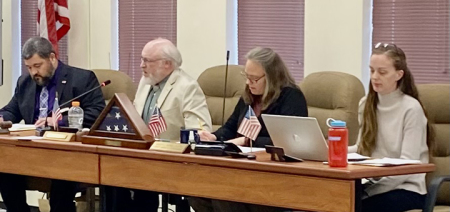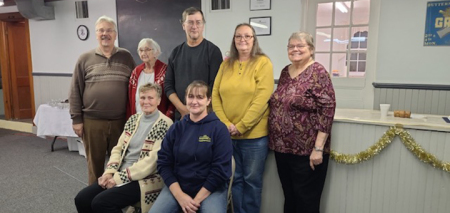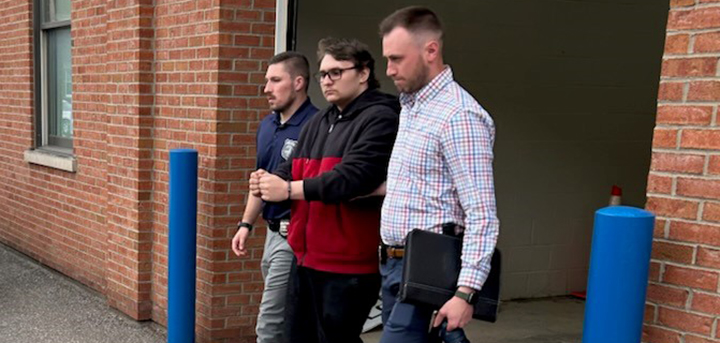Project Chenango: Chenango’s Health Care Issues
Published:
October 1st, 2015

By Melissa Stagnaro
Special to The Evening Sun
CHENANGO – Battling stage IV cancer requires your full attention. Yet Rebecca Sands Bliss has found herself having to divide hers between fighting both it and her insurance at the same time
It started in December of last year, when Bliss, saw an ear, nose and throat specialist about some sinus issues she was having. The doctor told her she had a polyp which was likely benign, and they scheduled surgery for May.
The 32-year old Norwich woman said she often thinks about that decision, and how different things might have been if she had chosen NOT to wait those five months.
“I should have had the surgery sooner,” she said, because then they would have realized the polyp was actually a tumor that much sooner.
When that diagnosis came – after she complained of other symptoms prior to the scheduled surgery – the tumor had already spread. A biopsy revealed it was Adenoid Cystic Carcinoma, a rare cancer that accounts for around 1,200 of the more than half a million new cancer cases diagnosed each year.
Because of the tumor’s size and location, it was classified as stage IV.
“Stage IV curable,” clarified Bliss. “The doctors have been positive about the outcome.”
In June, Rebecca underwent a highly invasive surgery to remove as much of the tumor as possible. Bone and tissue from her leg were used to partially reconstruct her upper jaw and roof of her mouth.
But the surgery – which has left her with difficulties eating and breathing, numbness, impaired speech, and even affected her ability to smile – was only the first step in battling her cancer. Because of the location of the tumor, she would also require radiation and possibly chemotherapy.
It was following the surgery, while she was suffering through setbacks in her recovery, that she first heard about Proton Therapy. A more precise form of radiation, Bliss’s oncologist told her it could mean a lower risk of long-term side effects. The problem was that, because it was only available at a few select facilities, she would need to be accepted as a patient in order to proceed.
What she didn’t realize was that she’d have a far more difficult time getting her insurance company to approve the potentially life-saving treatment than finding a program to take her.
A month after she started investigating the Proton Therapy option, Bliss was accepted as a patient at the Hospital of the University of Pennsylvania in Philadelphia. It was then, however, that she met a major obstacle: her insurance company, MVP, denied coverage of the treatment.
It was a rude awakening for Bliss.
“My insurance company was overriding what my doctor, a professional in the field, felt was best for me. That’s when I began to really understand the true problems people face with the health insurance system,” she said.
“Doctors are not being allowed to decide what is best for their patients. The insurance companies are deciding and making it difficult on doctors to do their jobs.”
According to Bliss, it wasn’t the denial of treatment she found most frustrating, but the hoops she was forced to jump through. Especially during a time when she needed to focus her energy on healing – and mentally preparing herself for what lay ahead.
“I was scared to death that I still had a tumor that had the potential to grow and time was being wasted trying to get approval for the treatment [my doctors] felt was best for me,” she explained.
Advocating for herself was a challenge, because speaking was difficult and exhausting and she struggled to be understood at times.
“This is exhausting for someone who is healthy, so you can imagine how much harder it was for me being tired after surgery, emotionally drained and unable to talk normally,” she said.
Then the insurance company agreed to reconsider its decision, but only if Bliss’s doctor did a comparison study to prove Proton Therapy was the best option.
“I could see how showing this study could help the insurance company make the right decision and could even agree with the logic behind it,” Bliss said. But what didn’t make sense to her was that, despite having requested the study, the insurance company wouldn’t confirm they’d pay for it.
Bliss and her family proceeded even without that confirmation, knowing that there was a chance they’d have to pay out of pocket for the study. Bliss said her doctors worked for two weeks to prepare the information requested by the insurance company – a process that required her to travel to Philadelphia where she had to endure a CT scan, an MRI and have two separate masks made for her face.
The result of those efforts was submitted to the insurance company – only to be denied in less than 24 hours.
“When they spent such little time looking at the study my doctor worked so hard on, it really upset me,” she said. “I did not feel like I was being treated like a human anymore – just a case number.”
This was on top of the frustration Bliss was experiencing every time she called the company to find out if they were going to pay for the study.
“It seemed like there was some sort of communication barrier,” she said.
When Bliss physically wasn’t able to advocate for herself due to pain or exhaustion, her father took the lead. Having always been fiercely independent, this was another frustration for her.
Feeling defeated, Bliss – who married her long-time best friend and sweetheart on August 30 – started looking at her new husband’s insurance coverage through the Empire Plan.
“I found I could be added right away,” she said. As they looked into his coverage more, they discovered she could have access to the Empire Plan’s CANCER Resource Network. One of the biggest selling points was that she wouldn’t need pre-determinations on her treatments.
It turned out it to be more complicated than they anticipated, but she credits the UPENN hospital for working with her new insurance company to overcome the last minute hurdles.
“I am so thankful to the staff and doctors at the hospital because they worked super hard and around the clock to get me approved,” she said.
She’s now a week and a half in to her new treatment schedule – already she’s had 7 of 38 Proton Therapy and radiation treatments and 2 of 7 chemotherapy appointments. She took time out of this aggressive schedule to say thank you to those who have supported her thus far.
Her parents, sister and husband are all on that list, as is her friend Ann Coe. Coe organized a fundraiser for her via gofundme.org, which has not only helped financially, but has also given Bliss a platform to share her story.
“I can’t believe the amount of vocal and financial support I have received from so many people,” she said, citing the cards, Facebook posts and donations that have poured in since her battle was made public on the Rebecca’s Virtual Run page.
“The ongoing support reminded me that I have to continue to fight for myself.”
It was that push, and the support of her family and new husband that keep her going – and fighting. If not for them, she says she probably wouldn’t be getting the care she needs.
“I would have settled for second best,” she said.
Her recommendation for others who may find themselves in a similar situation? Don’t give up.
“If you are unable to fight for yourself, find someone who is,” she said. “Share your story. You never know who might be able to help.”
Her reason for sharing her own story is a compelling one.
“I think we have a real problem with health insurance,” she said. “People who are sick should not have to fight so hard to get the care they need to live.”
She admits that before she lived through this herself, she had largely written off criticisms she heard about the health care system as conservative rhetoric.
“Unfortunately, it’s not a story,” she said. “Something needs to change.”
While not everyone may experience a situation as extreme as Bliss, the current health care climate is proving challenging to navigate for many – from patients to providers, pharmacies and more.
THE PLIGHT OF SMALL HOSPITALS
Hospitals are also feeling the crunch.
“It’s a very challenging time, particularly for small rural hospitals,” said Chris Kisacky, vice president of operations for UHS Chenango Memorial.
According to the hospital administrator, 60 percent of in-patients who receive care at Chenango Memorial are covered by Medicare. The services they receive are then reimbursed through the federal and state government.
The problem?
“Those reimbursements are dropping,” she said, with providers only receiving ‘pennies on the dollar.’
And those reimbursements could drop even further as a result of health care reforms soon to go into effect.
“Medicare will withhold money,” Kisacky explained. “We don’t earn it back unless we meet certain criteria.”
Part of the criteria is the number of hospital admissions and emergency room visits deemed ‘avoidable.’ In the case of those ER visits, that means people using the emergency room when they could have seen a primary care provider or gone to a walk-in or urgent care clinic. Chenango Memorial has been working to address this issue in part by recruiting more primary care providers to the area. But there are still patients who seek out the ER because they may lack insurance or feel it’s their only option.
UHS Chenango Memorial is also seeing another trend: as more people move to high deductible health insurance plans, the hospital is having to write off more and more bad debt.
“It’s not an unwillingness to pay,” said Kisacky. “It’s an inability.”
This year, the hospital will write off $6 million in bad debt. Next year, it could be as high as $7 million, she said.
Rather than encourage people to make use of preventative care options, Kisacky said these high-deductible plans sometimes have the unintended consequence of discouraging people from being more proactive. They’ve seen people waiting longer to go to the doctor.
“Disease states are much further along,” she said.
UHS Chenango Memorial is trying to rise to meet these challenges by becoming a leaner organization, doing ‘more with less’ while maintaining the standards of care they provide.
“We’re committed to our region,” Kisacky said, and working hard to remain a healthy organization.
PRESCRIPTION FOR FRUSTRATION
Hospitals and providers aren’t the only ones suffering through these changes.
“Health care is changing drastically,” said Heather Bartle Ferrarese, a clinical pharmacist at Bartles Pharmacy in Oxford.
Her family has been in the pharmacy businesses since 1963.
“The greatest reward for us is to make a difference in the community and peoples’ lives,” she said. “We truly care about our patients and their healthcare.”
According to Ferrarese, it’s that bond and those personal relationships that make the long hours, hard work and the challenges all worth-while – even now, when the very fundamentals of the business are changing.
“In the past, health care was provided as a fee for service,” she said. “Now the push is that providers – pharmacies included – will be paid for performance.”
Ferrarese explained that in this model, pharmacies are given ‘performance goals’ from various insurance companies. The rating will ostensibly help patients select a pharmacy, but those insurance companies will also use them when negotiating contracts.
“An unintended consequence of this is most insurance plans are making it harder to obtain the medication your provider has ordered,” Ferrarese said, and may require a provider obtain prior authorization – including explaining to the insurer why a particular drug is needed. This process can take anywhere from a few hours to days or even weeks.
All of these changes are making it particularly hard for local pharmacies like Bartles to stay both relative and competitive with large chains, with employers who require employees to use mail order services, and the agreements between insurance companies and big-box retailers that have begun to monopolize the market.
Every night, she said, they run a report that stretches at least two pages – all prescription drugs they now take a loss on so they can continue to serve their customers.
NAVIGATING MEDICARE
Ferrarese is keenly aware of how other health care issues are affecting the pharmacy’s customers, particularly the senior population.
According to Brian Wessels, approximately 11,000 Chenango County residents – around one-fifth of the county’s population – are over 60. Once they turn 65, they’re eligible for Medicare, the acting director of Chenango County’s Area Agency on Aging explained.
Navigating Medicare and its parts (A, B and D), supplemental plans and Advantage plans, can be confusing, Wessels said. Especially since people are often unprepared for the complexity and the expense associated with it. They can be blindsided when they hit retirement age, only to find out they may need to continue working part time just to cover medical expenses or premium costs. That’s one of the reasons he feels so strongly about the agency’s outreach and education efforts.
The good news is seniors don’t have to go it alone.
“We’re here as a resource for people,” Wessels said. His agency has a team of staff and volunteers capable of counseling on different insurance products - from Medicare, to prescription drug and long-term care insurance. He suggests people call 337-1770 for an appointment, so they are prepared and can get the most out of their session.
Open enrollment for Medicare runs from October 15 through December 7, so it’s the perfect time for anyone just ‘aging’ into Medicare to schedule an appointment, he explained.
There are a couple of things he would like everyone to know as this open enrollment window approaches.
“Medicare pays for quite a number of preventative services,” he explained, many of which he feels are underutilized. One is a wellness check up. This visit to a primary care physician helps establish a baseline, and is covered 100 percent by Medicare.
Medicare also covers flu and pneumonia vaccines, he stressed.
AVAILABLE RESOURCES
Wessels and his team refer those who aren’t Medicare-eligible to other agencies, such as the Southern Tier Independence Center and Chenango Health Network.
“Chenango Health Network helps individuals and families to apply for health insurance, including Medicaid, through the New York State Marketplace,” explained the agency’s executive director, Tina Utley Edwards.
In addition, CHN’s Community Health Advocate program ‘helps people to understand their insurance benefits, address problems with billing or insurance, find health care providers and other services,” she said.
They also help people obtain certain prescription medications and, in the case of breast cancer patients, help them obtain care not covered by insurance and even cover some travel expenses related to their treatment.
Comments







